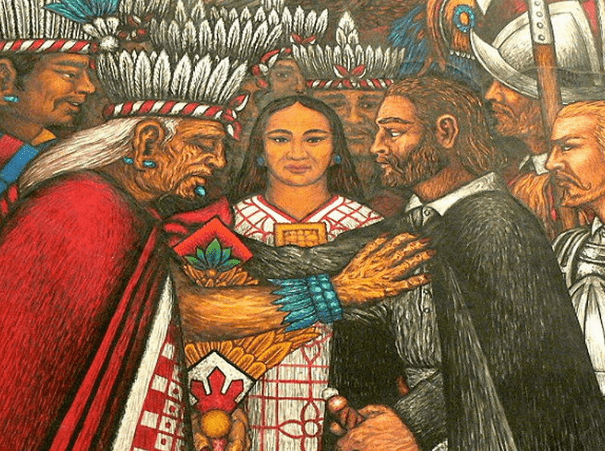Winner of the Fall 2016 StMU History Media Award for
Best Article in the Category of “People”
Best Article in the Category of “World History”
Largely due to the importation of disease and use of superior weapons, the Spaniards were able to conquer the Aztec capital of Tenochtitlan, kill the empire’s last emperor, Cuauhtémoc, and bring the Aztec empire to an end. Few know of La Malinche, the indigenous interpreter of Hernán Cortés, whose linguistic abilities were used to facilitate important conversations between the Spaniards and the indigenous leaders. Without the help of La Malinche, perhaps the Aztec empire would have survived.
Born between 1502 and 1505, La Malinche was named Malinalli Tenepal, the first part of her name being a Nahuatl term for the twelfth day of the month in correspondence to the Aztec calendar, and the second part of her name meaning “lively.” She was born of nobility in Paynala within the region of Veracruz. Her troubles started at a young age after the death of her father. La Malinche was ousted from her home to ensure her new half-brother received the inheritance of the family instead of her, since she was the eldest child. She was given to “some Indians of Xicalango.”1 Then the Indians gave her to a nobleman in Tobasco, a region in the Yucatan. When Cortés arrived to Tobasco, he was offered twenty slaves, one of them being La Malinche. Having lived in Veracruz, a Nahuatl-speaking region, and then being sold into a Maya-speaking region, La Malinche knew both languages and she was soon recognized for the linguistic talents that could benefit Cortés in his conquests.2

The few glimpses of La Malinche and how her presence as an interpreter accelerated the fall of the Aztec empire can be found in the writings of the Spanish explorers, specifically from Hernán Cortés, her “lord and master.”3 From the second letter Hernán Cortés wrote to Emperor Charles V, dated October 30, 1530, Cortés speaks of La Malinche as “a female interpreter that I had, who was a native of this country, and whom I obtained at Putunchún on the Rio Grande.”4 This confirms the vague aspects of her life that we already know. But most importantly, in this context, this letter goes on to tell of a scenario in which La Malinche saved the Spaniards from an ambush by the Cholulans. La Malinche was told by the wife of a native leader that they planned to attack the Spaniards and if La Malinche came with them, she would be protected. La Malinche delivered this message to Cortés, which ultimately led to the massacre of Cholula and provided a direct path to march towards Tenochitlan, the capital of the Aztec empire.5 This leads to the question of whether or not La Malinche was a traitor or a survivor. Did she explicitly want the Aztec empire to fall or did she just want to save herself from the carnage?
With no traces of primary sources from La Malinche herself, her story has been retold by various scholars without much consistency, nothing ever being certain. Up until the twentieth century, La Malinche was viewed as a traitor to her country Mexico. In 1861, on the celebration day of Mexico’s Independence, Ignacio “El Nigromante” Ramírez, a Mexican journalist, addressed the Mexican people by saying, “One of the mysteries of fate is that every Mexican owes his downfall and disgrace to a woman, and to another woman his salvation and glory; the myth of Eve and Mary is reproduced everywhere; we indignantly remember Cortés’s mistress and will never forget, in our gratitude to Doña María Josefa Ortiz.”6 La Malinche is seen as playing a key role in the subjugation of the Mexican peoples to Spain, while Doña María Josefa Ortiz did the contrary and liberated the country. However, many Chicana writers and modern scholars are trying to rewrite the tale of La Malinche to understand the complexities of her choices and to vindicate her. For example, Gloria Anzaldua promotes the idea that La Malinche had a “new consciousness,” that she voluntarily served as the interpreter of Cortés not only to save herself, but also because she knew that a new mestiza culture was going to be born (especially considering she had a son with Cortés in 1524).7 She made a conscious effort to exchange language and cultural aspects from each side in order to facilitate the emergence of the new mestiza society; however, with that came brutal consequences in the shape of warfare and mass death in the New World.
Whether or not La Malinche’s role as Cortés’s interpreter was traitorous, simply an effort to survive, or some other complex reason involving love for Cortés, hate for the Aztec empire for the cruelty she faced after being ousted from her home, or promotion of the new mestiza culture, no one will ever know the true story of the Indian, slave woman who traveled alongside Cortés towards the culmination of the Aztec empire.
- Bernal Castillo del Díaz, The Discovery and Conquest of Mexico, 1517-1521 rev. American ed., trans. A.P. Maudsley (New York: The Noonday Press, 1965), chap. 22-23. ↵
- Pilar Godayol, “Malintzin/ La Malinche/ Doña Marina: re-reading the myth of the treacherous translator,” Journal of Iberian and Latin American Studies 18, no. 1 (April 2012): 61-68. ↵
- Castillo del Bernal, chap 23. ↵
- Hernan Cortes to Emperor Charles V, October 30, 1520, in Letters of Despatches of Hernando Cortes, to the Emperor Charles V., trans. (New York: Wiley and Putnam, 1843), letter II. ↵
- Hernan Cortes to Emperor Charles V, October 30, 1520, in Letters of Despatches of Hernando Cortes, to the Emperor Charles V, letter II. ↵
- Rosario Pérez-Lagunes, “The Myth of La Malinche: From the Chronicles to Modern Mexican Theater” (PhD dis., Virginia Polytechnic Institute and State University, 2001), 24. Although she was of Spanish descent, Doña María Josefa Ortiz was born in Valladolid, Mexico in 1768 and identified herself as Mexican. She and her husband were both a part of the rebellion that ultimately led to Mexico’s independence from Spain in 1824. ↵
- Godayol, 68-70. ↵



230 comments
Paula Salinas Gonzalez
I really enjoyed reading your article because of the different viewpoints. However, whether it was to save herself or not, I do believe that La Malinche betrayed her people. Because it was mentioned that she was outcasted and sold into slavery, she might’ve betrayed them out of hatred. Either way, it is still very impressive that as a woman. she was the Spaniards’ interpreter.
Eva Lizarraga
I’ve never heard of La Malinche, so this was a very interesting read! You did a great job of providing enough information to hear out both sides, but still make sure the reader knows that much of the story is still missing. Personally, after reading this article, it’s hard not to view her as a survivor. She didn’t exactly owe anything to the Aztec empire, seeing as she was treated so harshly by them, plus the added factor that she was going to have a baby with Cortes, therefore able to envision a new future with the Spaniards. Nice work!
Sara Alvirde
This is a great article and such an important piece of history, Dona Marina made such an impact on the lives of Aztecs and the progress of the Spaniards being able to conquest through Mexico. Her decision is seen as a betrayal but maybe she didn’t want to die. Very sad story to say the least.
Andrea Laguna
Interesting article! I have never heard before of “la Malinche”. I like how you told her story from an unbiased point of view, and named the different scholar’s interpretations of her actions. To be honest, I would consider her a traitor, since she wouldn’t know for sure if the mestizo culture would be born. Regardless, I can understand why she could have decided to be in the Spaniards side, since she was rejected by her people on several occasions.
Malleigh Ebel
This article gave me some new perspective on the story of La Malinche. I always felt she was more of a traitor, but reading this makes me realize that it is more complicated than that. This article showed La Malinche’s side of the story more clearly and that she was a slave gifted to Cortes. I always thought she went willingly to be their interpreter but that seems to be less of the case. This was very informative.
Shanita Frazier
Loved this article. It seems like people really didn’t have an idea of who she was or what she did because there were different people who thought she was either a traitor or a survivor. But from reading this article I think she will be remembered as a female interpreter native to the country or she may be remembered for accelerating the fall of the Aztec Empire. Very Good!
Brittney Carden
Amazing article! We had covered Cortes’ translator briefly in class, but I had no idea she was such a controversial historical figure. I’d like to think of La Malinche as a survivor. She was cruelly treated in the Aztec empire, ousted for being a woman, and then was forced into slavery. I believe at this point in her life she was just trying to protect herself and her own future, regardless of the consequences.
Alexander Johnson
This was an interesting article. On the topic of her decision, something that would be helpful to know was how powerful the Cholulan army was. Given the fact that they were slaughtered, it seems possible that even with a sneak attack, they could be ill equipped to defeat the Spanish. If that was the case (given this is a large assumption), it wouldn’t make much sense for La Malinche to side with the Cholulans as she herself would be likely slaughtered in that case.
Yamilet Muñoz
Great Article! Your stance is allowing different points of view and possible different storylines are something that is valuable to researchers and historians. Sadly, many come up with few conclusions due to the minimal amount of evidence found, but I think you did a great job with allowing the possibilities of the story that comes with La Malinche due to the circumstances that are happening to many other women like herself.
Christopher McClinton
This article is a clear demonstration of survival in a hostile situation . In certain situations you have to know what the situation is in order to understand why people make the decisions that they make. Sometimes individuals are backed into a corner and that is the only option available to them. This was about survival clearly.